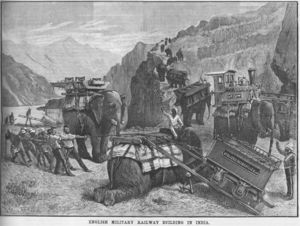Decauville Portable Railway System
Decauville Portable Railway System
Decauville was a manufacturing company founded by Paul Decauville (1846–1922), a French pioneer in industrial railways. Decauville's major innovation was the use of ready-made sections of light, narrow gauge track fastened to steel sleepers; this track was portable and could be disassembled and transported very easily [1]
Starting in 1875 the company produced track elements, locomotives and wagons. These were exported to many countries [1].
The 'Scientific American', 15 Aug 1885, printed an article that originally appeared in the French magazine, 'L'Ilustration' [2], which states:-
"The English army has succeeded in establishing a portable railway on several points of the Bolan Pass. This railroad is of the Decauville system, formed in sections of small steel rails, which can be put down or taken up very quickly. This ingenious railway - which has been used considerably for work on the Panama Canal and for the transportation of sugar cane in Australia and Java - has become the indispensable means of transport in all wars. It is at present being used in Tonquin and Madagascar by the French army, and is also being used on the Red Sea by the Italian army. When the Russian government commenced the war in Turkestan, in 1882, it bought one hundred versts, or about 66 miles, of the Decauville railroad, which Gen. Skobeleff used with great success for the transportation of potable water and for all the provisions for his army. This railroad was taken up as the army marched forward, and when the Russians advanced recently, in Afghanistan, the little railway appeared at the advance posts, and was described to the English army by the officers who watched the operations for the Afghans. An order for a similar apparatus was given by the English government to M. Decauville, directions being given that the road should be of the same type as that furnished to the Russians. The object of this was, probably, that any sections of road which might be captured from the Russians during the war could be used by the English. In this last order there was one problem which was very difficult to solve; all the material had to be carried by elephants, and they wanted a locomotive. M. Decauville had the locomotive made in two parts, the larger of which weighed on 3,978 pounds(1404kg) , the greatest weight that an elephant can carry."
Bolan Pass Railway Construction
Orders for a feasibility survey for the Bolan Pass Railway were first issued by the British Government in 1876 [3].
The Quetta Link Railway had reached Sibi on 2 May 1880 [4].Work on the construction of railways through the Pass started in 1880 but was soon stopped after laying of 31km track due to the occurrence of the famous Battle of Maiwand in the area.
Work restarted shortly after using the Decauville Portable Railway System by rapidly laying a rail track in the bed of the river Bolan and finally a steam locomotive rolled into Quetta in August of 1886. The 1885 account given in Practical Machinist [5] states "This railroad is of the 'Decauville System', formed in sections of small steel rails, which can be put down or taken up very quickly.... the locomotive made in two parts, the larger of which weighed on 3,978 pounds, the greatest weight that an elephant can carry”[5].
References
- ↑ 1.0 1.1 Wikipedia "Decauville"; Retrieved 11 Mar 2017
- ↑ "Practical Machinist" 26 Oct 2010 'Indian Railway Topic' by Robert Grauman; Retrieved 11 Mar 2017
- ↑ "Railway line through the Bolan Pass By Owais Mughal" published by 'All Things Pakistan', 23 Aug 2006; Retrieved 5 Dec 2016
- ↑ “Administration Report on Railways 1918” page 108 (pdf117); Retrieved 12 Mar 2017
- ↑ 5.0 5.1 "Elephants carrying locomotives through the Bolan Pass" – ‘Scientific American’, 15 August 1885; Posted 28 March 2010; Retrieved 5 Dec 2016
